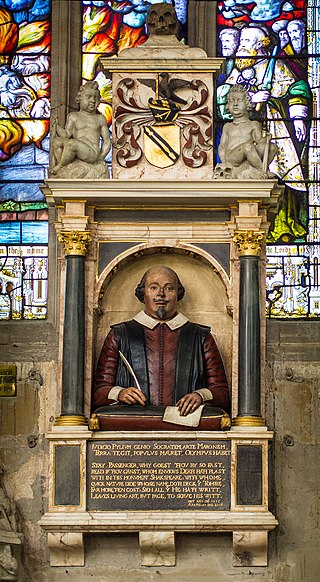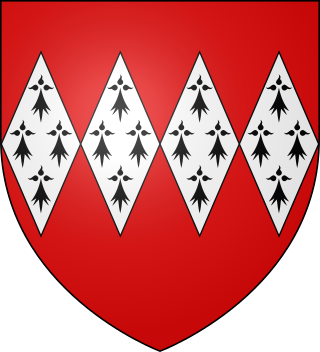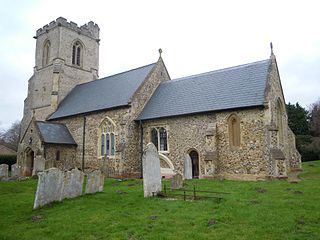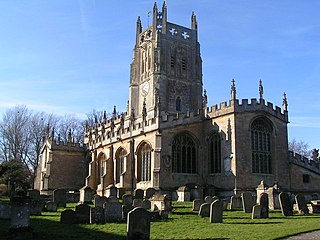
A cadaver monument or transi is a type of funerary monument to a deceased person, featuring a sculpted tomb effigy of a skeleton, or of an emaciated or decomposing dead body, with closed eyes. It was particularly characteristic of the Late Middle Ages when they were designed to remind viewers of the transience and vanity of mortal life, and the eternity and desirability of the Christian after-life. The format is in stark contrast to gisants, which are always recumbent, in full dress, with open eyes and hands clasped and raised in prayer.

Biggleswade is a market town and civil parish in Central Bedfordshire in Bedfordshire, England. It lies on the River Ivel, 11 miles (18 km) south-east of Bedford. Its population was 16,551 in the 2011 United Kingdom census, This figure increased by 36% to 22,541 at the time of the 2021 United Kingdom census.

Sir William Butts was a member of King Henry VIII of England's court and was the King's physician.

A monumental brass is a type of engraved sepulchral memorial once found through Western Europe, which in the 13th century began to partially take the place of three-dimensional monuments and effigies carved in stone or wood. Made of hard latten or sheet brass, let into the pavement, and thus forming no obstruction in the space required for the services of the church, they speedily came into general use, and continued to be a favourite style of sepulchral memorial for three centuries.

The Shakespeare funerary monument is a memorial to William Shakespeare located inside Holy Trinity Church at Stratford-upon-Avon in Warwickshire, the church in which Shakespeare was baptised and where he was buried in the chancel two days after his death.

John Waltham was a priest and high-ranking government official in England in the 14th century. He held a number of ecclesiastical and civic positions during the reigns of King Edward III and Richard II, eventually rising to become Lord High Treasurer, Lord Privy Seal of England and Bishop of Salisbury. He is buried in Westminster Abbey, London.

Brightwell Baldwin is a village and civil parish in Oxfordshire, about 4+1⁄2 miles (7 km) northeast of Wallingford. It was historically in the Hundred of Ewelme and is now in the District of South Oxfordshire. The 2011 Census recorded the parish's population as 208. The parish is roughly rectangular, about 2+1⁄2 miles (4 km) long north–south and about 1+1⁄4 miles (2 km) wide east–west. In 1848 the parish covered an area of 1,569 acres (635 ha). The B4009 road linking Benson and Watlington forms part of the southern boundary of the parish. The B480 road linking Oxford and Watlington forms a small part of its northern boundary. Rumbolds Lane forms much of its western boundary. For the remainder the parish is bounded largely by field boundaries.

Sir John Arundell (1495–1561), of Trerice, Cornwall, nicknamed "Tilbury Jack", was a commander of the Royal Navy during the reigns of Kings Henry VIII and Edward VI and served twice as Sheriff of Cornwall.

John Dynham, 1st Baron Dynham, KG of Nutwell in the parish of Woodbury and of Hartland, both in Devon, was an English peer and politician. He served as Lord High Treasurer of England and Lord Chancellor of Ireland. He was one of the few men to have served as councillor to Kings Edward IV, Richard III and Henry VII and was trusted by all of them.
Thomas Fisher (1772–1836) was an English antiquary.

St Mary's Watford is a Church of England church in Watford, Hertfordshire, in England. It is an active church situated in the town centre on Watford High Street, approximately 25 kilometres (16 mi) outside London. St Mary's is the parish church of Watford and is part of the Anglican Diocese of St Albans. Thought to be at least 800 years old, the church contains burials of a number of local nobility and some noteworthy monumental sculpture of the Elizabethan and Jacobean eras.

St Andrew and St Mary's Church is a Grade I listed Church of England parish church dedicated to Saint Andrew and Saint Mary, in the parish of Easton and the village of Stoke Rochford, Lincolnshire, England. The church is 5 miles (8 km) south from Grantham, and at the western side of the Lincolnshire Vales in South Kesteven.

St Michael's Church at Chenies, Buckinghamshire, is a Grade I listed Anglican parish church in the Diocese of Oxford in England. It is not of great architectural interest but stands in an attractive position in the Chess Valley near the Chenies Manor House. The church is famous for its Bedford Chapel, the mausoleum of the Russell family which is private and not open to the public.

The large parish church of St Giles, which is in the village of St Giles in the Wood, Devon, England, came into being in 1309. When it was restored in 1862–3, many monuments were retained, including the monument and effigy of Thomas Chafe of Dodscott, three monumental brasses, of Alenora Pollard, Margaret Rolle of Stevenstone and a small brass of her husband John Rolle (d.1570). There are also 19th- and 20th-century monuments to the Rolle family.

A ledger stone or ledgerstone is an inscribed stone slab usually laid into the floor of a church to commemorate or mark the place of the burial of an important deceased person. The term "ledger" derives from the Middle English words lygger, ligger or leger, themselves derived from the root of the Old English verb liċġan, meaning to lie (down). Ledger stones may also be found as slabs forming the tops of tomb chest monuments.

St Nicholas' Church is an Anglican parish church in Stevenage, a town in Hertfordshire, England.

St Andrew's Church is the Anglican parish church for the town of Biggleswade in Bedfordshire, England. The church is Grade II* listed and comes under the Diocese of St Albans. The church is noted for its monumental brass of John Rudying of 1481 featuring the Figure of Death.

The Church of All Saints in Radwell in Hertfordshire is an Anglican parish church which falls within the Diocese of St Albans. It is a Grade II* listed building, having gained that status in 1968.

The Church of All Saints is the Anglican parish church for the village of Willian in Hertfordshire. The benefice is united with St Paul's church in nearby Letchworth, although each church has its own parish. It is in the Diocese of St Albans. The church has been a Grade II* listed building since 1954.

St Mary's Church is a Church of England church in Fairford, Gloucestershire, England. It is notable for its complete set of 28 medieval stained-glass windows, one of the best-preserved in England. Part of the tower dates from the early 15th century. The church was rebuilt at the end of the 15th century by John Tame (c.1430–1500), a wealthy local wool merchant. It is a Grade I listed building in the Perpendicular style.




















